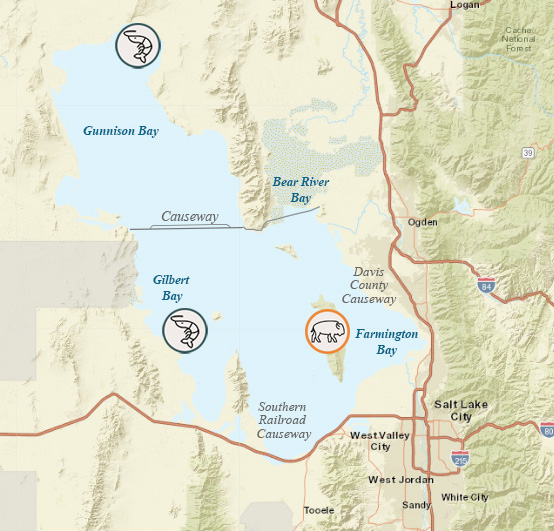Great Salt Lake Hydro Mapper
The Great Salt Lake is of regional and hemispheric biological importance due to its role as a major North American migratory bird flyway, as vital shorebird breeding habitat, and due to its enormous size and influence on the climate and ecology of the area. Because the chemistry of the Great Salt Lake ecosystem is dominated by sodium and chloride, the vegetation communities that are associated with the Great Salt Lake habitats are primarily saline tolerant and contain plant species that are uniquely adapted to hypersaline conditions in the lake (e.g., algae) and saline and alkaline conditions in surrounding wetlands and uplands (e.g., submergent, emergent, and upland plants). Saline-tolerant algae serve as the primary food for the brine flies and brine shrimp that support the Great Salt Lake food chain. The very flat gradient of the lake bottom causes dramatic fluctuations in the shoreline of approximately 460 feet per foot of lake level change (up to 880 yards seasonally) and results in a diversity of shoreline habitats, including ephemeral pools, mudflats, vegetated playas, and sand bars. The transitory nature of Great Salt Lake water levels and shorelines are a fundamental component of the biological productivity of the lake and its value to migratory shorebirds and the brine shrimp industry.

Approximate locations of brine shrimp and antelope and bison habitats in the Great Salt Lake. Icons surrounded by an orange circle indicate current lake level has an adverse effect. Icons surrounded by a blue circle indicate no data. Bird habitat locations are shown on the Wetlands Characteristics map.
Approximately 250 species of birds, 64 species and subspecies of mammals, 23 species and subspecies of fish, 19 species of reptiles, and eight species of amphibians have been documented in the Great Salt Lake environs.

The effects of lake level on birds that use Great Salt Lake habitats are highly variable and are based on the specific requirements of individual species. One very important aspect of the Great Salt Lake for migratory and nesting birds is the transitory nature of the shoreline. The flooding and drying of the mudflats and wetlands around the Great Salt Lake create conditions where new resources become available and foraging areas shift over time.
Foraging birds have changing effects based on the transition of lake level, where a slow degradation of conditions occurs over a variable lake level range.
The Great Salt Lake shoreline that shifts constantly over time, changing the habitat at a specific location from flooded to completely dry.
Fish eaters (piscivores) cannot be sustained once the lake reaches approximately 4,200 feet due to a complete loss of fish.
Island colonial nesters are found on a few of the islands in the Great Salt Lake. These islands are connected to the mainland at low lake levels, thus allowing land-based predators to access the nests, which are on the ground. For these species, high lake levels keep nesting areas isolated. Artificial structure nesters are defined as either colonial or noncolonial nesting birds that nest on human-made structures, which are typically dikes or levees. Most of these features are related to wildlife and WMAs or salt evaporation ponds. At certain lake levels, all of these dikes and levees are inundated and nesting areas are reduced.
Antelope and Bison live on Antelope Island. When lake levels are high, these mammals are isolated on the island. When lake levels drop, the island becomes connected to the mainland.
Information on this page is from the Final Great Salt Lake Comprehensive Management Plan and Record of Decision.
Banner photo: Bison grazing on Antelope Island. Photo courtesy of Juozas Rimas through Wikipedia.